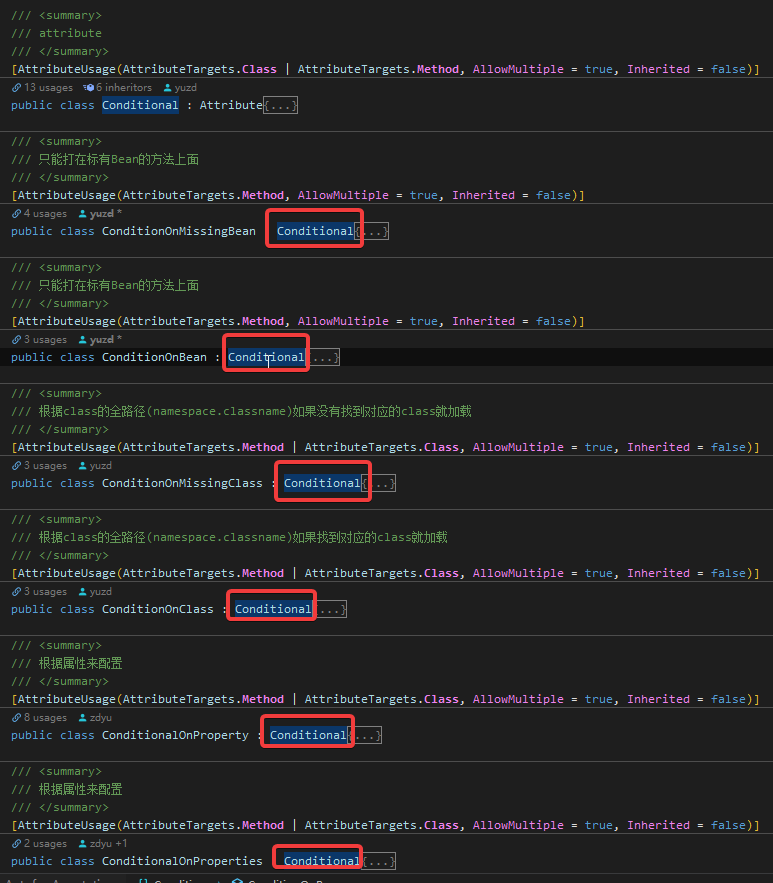Autofac实现有条件的DI
Autofac.Annotation框架是我用.netcore写的一个DI框架,基于Autofac参考 Spring注解方式所有容器的注册和装配,切面,拦截器等都是依赖标签来完成。
开源地址:https://github.com/yuzd/Autofac.Annotation
本期讲的是最新实现的功能
有条件的DI
有些时候我们想要满足xxx条件才把一个类注册到容器里面。比如如何切换Services,如果是Spring,可以根据条件注册Bean和Configuration。所以我参考Spring的条件注解也在我的Autofac.Annotation框架中也实现了以下注解:
| 注解 | 使用方式 | 备注 |
|---|---|---|
| Conditional | 打在class或者方法上面 | 条件加载,自定义实现的 |
| ConditionOnBean | 打在标有Bean注解的方法上面 | 条件加载 |
| ConditionOnMissingBean | 打在标有Bean注解的方法上面 | 条件加载 |
| ConditionOnClass | 打在class或者方法上面 | 条件加载 |
| ConditionOnMissingClass | 打在class或者方法上面 | 条件加载 |
| ConditionOnProperty | 打在class或者方法上面 | 条件加载 |
| ConditionOnProperties | 打在class或者方法上面 | 条件加载 |
| DependsOn | 可以配合Bean和Component使用 | A的实例化依赖另一个B的实例化,但是A并不需要持有一个B的对象 |

下面来讲讲使用方法:
ConditionOnBean和ConditionOnMissingBean
这2个注解是只能配合Bean注解一起使用,且只能打在方法上面,不能打在class上面
-
ConditionOnBean的意思是,如果指定的类已经被注册的话,我才要注册。
[AutoConfiguration]
public class Test10Config
{
[Bean]
[ConditionOnBean(typeof(Test10Model3))]
public Test10Model5 getTest10Model5()
{
Console.WriteLine("registered Test10Model5");
return new Test10Model5();
}
}
上面的代码的意思是,如果Test10Model3被注册的话,才会注册Test10Model5
-
ConditionOnMissingBean的意思是,如果指定的类没被注册的话,我才要注册。
[AutoConfiguration]
public class Test10Config
{
[Bean]
[ConditionOnMissingBean(typeof(Test10Model1))]
public Test10Model3 getTest10Model3()
{
Console.WriteLine("registered Test10Model3");
return new Test10Model3();
}
}
上面的代码的意思是,如果Test10Model1没被注册的话,才会注册Test10Model3
ConditionOnClass和ConditionOnMissingClass
这2个注解是配合Compoment或者AutoConfiguration,PointCut等注解一起使用,可以打在class和method上面,该注解的参数需要填入类的完整名称
-
ConditionOnClass的意思是如果当前运行环境存在指定的类的话,就注册
[Bean]
[ConditionOnClass("Autofac.Annotation.Test.Test10Model2,Autofac.Configuration.Test")]
public Test10Model6 getTest10Model6()
{
//找的到class 所以可以注册Test10Model6
Console.WriteLine("registered Test10Model6");
return new Test10Model6();
}
-
ConditionOnMissingClass的意思是如果当前运行环境不存在指定的类的话,就注册
[Bean]
[ConditionOnMissingClass("Autofac.Annotation.Test.test10.Test10Model2,xxxx")]
public Test10Model7 getTest10Model7()
{
//找不到class 所以注册Test10Model7
Console.WriteLine("registered Test10Model7");
return new Test10Model7();
}
ConditionOnProperty和ConditionOnProperties
这2个注解可以配合Bean,Compoment,AutoConfiguration,PointCut等注解一起使用,可以打在class和method上面
意思是,如果数据源(读取当前项目的appsettings.json)
-
指定的key对应的值为xxx时 -
或者不存在指定的key
就注册
appsettings.json
{
"onproperty": "on"
}
-
里面存在指定的key为xxx时就注册
[Bean]
[ConditionalOnProperty("onproperty", "on")]
public Test10Model8 getTest10Model8()
{
//因为配置文件onproperty的值为on 所以会注册
Console.WriteLine("registered Test10Model8");
return new Test10Model8();
}
-
或者不存在指定的key
[Bean]
[ConditionalOnProperty("onproperty1", matchIfMissing = true)]
public Test10Model10 getTest10Model10()
{
//由于配置文件里面没有onproperty1 所以会注册
Console.WriteLine("registered Test10Model10");
return new Test10Model10();
}
当想要指定多个值同时满足的话就用ConditionOnProperties,道理是一样的~!
Conditional
这个注解接受一个实现了ICondition接口的Type类型的参数。具体的判断条件由自己实现(比如上面的几个条件注解都满足不了你,那你就用这个注解搭配自定义的条件)
首先我们定义一个class实现ICondition接口的ShouldSkip方法,下面的类的意思看注释应该可以明白:
public class Test10Condition : ICondition
{
/// <summary>
/// 只有当 windows 系统下才被注册
/// </summary>
/// <param name="context"></param>
/// <param name="metadata"></param>
/// <returns>返回true代表不满足条件,那就不会被注册到容器</returns>
public bool ShouldSkip(IComponentRegistryBuilder context, object metadata)
{
if (RuntimeInformation.IsOSPlatform(OSPlatform.Linux))
{
//是linux系统 就不注册
return true;
}
if (RuntimeInformation.IsOSPlatform(OSPlatform.OSX))
{
//是mac系统 也不注册
return true;
}
//是windows系统 那就注册
return false;
}
}
下面我们来使用上面的条件用Conditional注解打在方法上面,这个条件表明了只有在windows平台才会将Test10Model1注册到容器中
[AutoConfiguration]
public class Test10Config
{
[Bean]
[Conditional(typeof(Test10Condition))]
public Test10Model1 getTest10Model1()
{
Console.WriteLine("registered Test10Model1");
return new Test10Model1();
}
}
上面的例子是结合Bean注解一起使用,Conditional注解还可以打在class上面,结合Compoment或者AutoConfiguration注解来实现满足条件才注册!
Conditional也是上面几个其他注解的父类

不同的是上面几个其他注解的构造方法都指定了自己默认的实现类。
这样面向设计的好处是在注册的初始化阶段针对验证条件的逻辑就可以统一处理:只搜集 Conditional或者Conditional的子类注解,且约束了条件判断的类统一得实现ICondition接口。
DependsOn
该注解可以配合Bean和Component注解一起使用,是用来表示一个 A的实例化依赖另一个B的实例化, 但是A并不需要持有一个B的对象
[Bean]
[DependsOn(typeof(Test12Bean4))]
public Test12Bean3 get13()
{
Debug.WriteLine("new Test12Bean3");
return new Test12Bean3 { Hello = "world" };
}
[Bean]
public Test12Bean4 get14()
{
Debug.WriteLine("new Test12Bean4");
result.Add("get14");
return new Test12Bean4 { Hello = "world" };
}
上面的意思是在需要加载Test12Bean3实例(还没)的时候,由于设置了DependsOn类Test12Bean4,先去加载Test12Bean4
[Component]
[DependsOn(typeof(Test12Bean8))]
public class Test12Bean7
{
public Test12Bean7()
{
//Console.WriteLine("然后我在加载")
}
public string Hello { get; set; }
}
[Component]
public class Test12Bean8
{
public Test12Bean8()
{
//Console.WriteLine("我先加载")
}
public string Hello { get; set; }
}
上面的意思是在需要加载Test12Bean7的实例的时候,先去加载Test12Bean8
好了,有条件的DI介绍到此,更多教程请参考项目wiki(教程很详细哦,别忘记给个star)
https://github.com/yuzd/Autofac.Annotation/wiki
关注公众号一起学习

如果您觉得阅读本文对您有帮助,请点一下“推荐”按钮,您的“推荐”将是我最大的写作动力!欢迎各位转载,转载文章之后须在文章页面明显位置给出作者和原文连接,谢谢。



【推荐】国内首个AI IDE,深度理解中文开发场景,立即下载体验Trae
【推荐】编程新体验,更懂你的AI,立即体验豆包MarsCode编程助手
【推荐】抖音旗下AI助手豆包,你的智能百科全书,全免费不限次数
【推荐】轻量又高性能的 SSH 工具 IShell:AI 加持,快人一步
· TypeScript + Deepseek 打造卜卦网站:技术与玄学的结合
· 阿里巴巴 QwQ-32B真的超越了 DeepSeek R-1吗?
· 【译】Visual Studio 中新的强大生产力特性
· 10年+ .NET Coder 心语 ── 封装的思维:从隐藏、稳定开始理解其本质意义
· 【设计模式】告别冗长if-else语句:使用策略模式优化代码结构